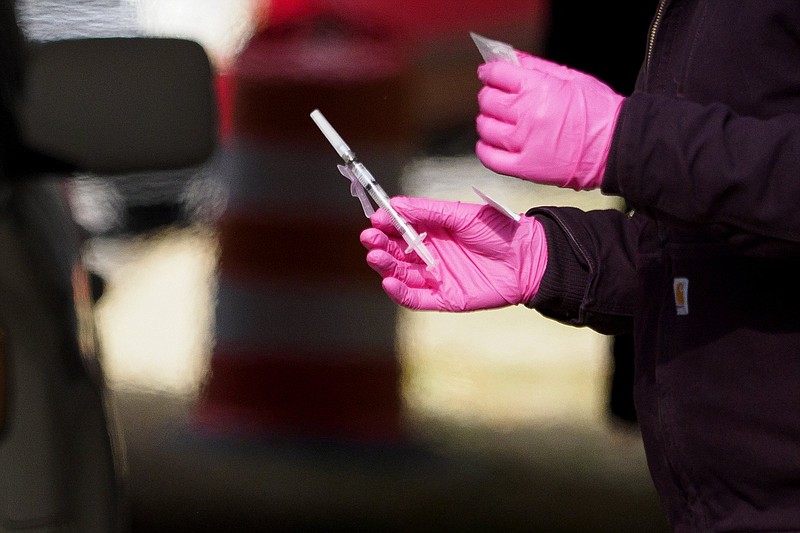It is heartening to see COVID-19 vaccines beginning to get pumped into arms in Hamilton County and surrounding communities. But it's disheartening to see it happening with so much disconnect.
Disconnect like the state's self-congratulatory pats on the back because medical experts and researchers across the country have applauded Tennessee's so-called equitable vaccination plan - one which supposedly was among the first in the nation to consider social vulnerability in distribution.
In reality, one month into our vaccination process, state health officials say they can't tell us how well the state's focus on equity is being implemented.
They instead say there are "unknowns" of race and ethnicity in COVID-19 vaccine data: As of Thursday, the demographic breakdown of administered doses was 44% "unknown" by race and 31% "unknown" by ethnicity, according to data from the Tennessee Department of Health.
Apparently that means Tennessee health officials can't read. In crisp black and white, the form being filled out by Hamilton County residents now receiving the vaccines asks clearly for that information.
The fifth line on the "COVID-19 Vaccine Encounter form" asks the registrant's race and provides six boxes to check. The sixth line asks the patient's ethnicity.
State health department spokesman Bill Christian blamed it on software.
"Current functionality of the software used to capture information during mass immunization events does not allow for the capture of this information," he said in a statement. "[The health department] has asked the vendor to update the software."
But Times Free Press reporters Wyatt Massey and Elizabeth Fite also were told the state is "not making available" county-level demographic data about who is receiving the COVID-19 vaccine.
So which is it? Data being "unknown" is considerably different from data not made available.
Of course, either answer is all very convenient for avoiding accountability or blame - a lesson surely learned from the Trump administration, which never took responsibility for the vaccine's distribution but left it instead up to the states. In turn, the states left it largely to county health departments. Pass the buck and pass the buck and pass the buck while our nation's deaths from COVID-19 reached a landmark 400,000.
COVID-19 memorial
City’s COVID-19 memorial: https://www.youtube.com/watch?v=Y8QzwE-BknM
Sadly, there's much more to this disconnect than just acknowledging or not acknowledging equity and fairness. Tomorrow's needs and policy are derived from watching today's data points.
"We need to know - as academics, as policy makers, as the general public - who's receiving the vaccine so that we can support those communities, those counties that need not only additional supply, but additional services to reach those who may not have a smartphone to make an appointment, for example, or couldn't travel to a stadium or a local retail pharmacy to receive the vaccine," said Dr. Rebecca Weintraub, assistant professor of global health and social medicine at Harvard Medical School.
Consider this, too: If Tennessee can't or won't figure out just who is getting vaccinated, how is it that Kaiser Health News knows?
According to Kaiser, Tennessee ranks fourth in the nation among states reporting the largest gap between the percentage of Black residents in the state population and the percentage of Black residents who have been vaccinated. Kaiser's data analysis says white residents are being vaccinated in Tennessee at double the rate of Black residents.
Beyond equity, there also is the matter of dollars and cents. Vaccines are free to citizens but hospitalizations are not. Black residents are 3.7 times more likely to be hospitalized with COVID-19 than whites, and Hispanic residents are 4.1 times more likely to be hospitalized than whites, according to the CDC. And, in the makings of a perfect storm, these essential workers are both more prone to pre-existing conditions and are far more likely to lack insurance, meaning taxpayers and charity are going to foot the bill when disproportionate numbers of them go unvaccinated.
Couple all this disconnect with reports that some residents, frantic for the vaccine and frustrated with its slow rollout, are crossing county and state lines to get shots if their local eligibility period hasn't yet arrived.
That may be well and good for folks with plane fare or a car new enough to make a road trip. But it means other eligible people are delayed in their turn to be vaccinated while some others jump line.
Left holding the bag for all of this - from Trump right down to the broken patchwork of states struggling to make policy-driven decision by governors like Bill Lee who still dithers on a statewide mask mandate - are our underfunded, understaffed county health departments.
Dr. Harald Schmidt, assistant professor of medical ethics and health policy at the University of Pennsylvania, praised the aspirations of these overwhelmed counties: "The devil so often is really in the details. And personally, I really think it's important that we cut health departments some slack here."
We think that, too. After all, we've never done anything quite like this before - a mass vaccination of hundreds of millions of people.
That's why it's so disturbing that Trump, his administration and our state officials left the burden to county health departments, then skated away from accountability.
